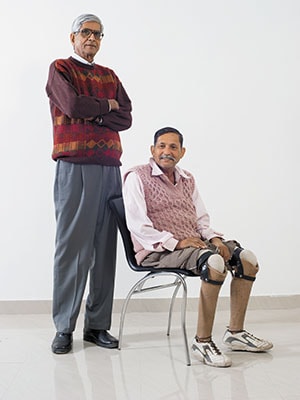
The Jaipur Foot's Standing Dilemma
The Jaipur Foot has pulled millions of disabled people out of their plight. But do its makers need a course correction to carry on?
Devendra Raj Mehta was a career bureaucrat who rose to the top, advising prime ministers as the deputy governor of RBI and taking on big corporate names during his stint as the Sebi chairman. But as one sits in his ‘office’ of over a decade, at the Bhagwan Mahaveer Viklang Sahayata Samiti (BMVSS) in Jaipur, the absence of any trappings of power from that 40-year career is striking. Mehta himself arrives in a modest hatchback and carries his bottle of water as he enters the office, which is also not his alone.
The room has two long tables joined as one, and half-a-dozen chairs around it. Mehta dictates mails to his secretary Khaleel, who types away at a laptop. Soon, his pet dog enters and nonchalantly climbs on to a corner chair and gets comfortable. Khaleel hands over a bunch of envelopes and papers to Mehta. These are cheques from donors, proposals from prospective partners and official communication from the local administration.
Every few minutes, there is a stream of people. They don’t need to knock or ask for permission to enter the room. They are all in need. Mehta addresses each of them and assigns his staff to help the visitors out.
“I’m sorry, we can’t serve you tea. You see, we want to use each rupee for the poor. We don’t even have tea during our board meetings unless a director sponsors it,” says Mehta, the founder and chief patron of BMVSS, which is better known for its product—the Jaipur Foot. One of his associates later added that to cut costs each of them even gets water from home.
Over the past 38 years, parsimony has been one of the reasons why BMVSS has been able to provide limbs to 1.3 million people for free. It has also developed a model that impresses many, entrepreneurs included, with its simplicity. “I have always read in management books that the best way to have an efficient operation is to keep it simple. But, as an entrepreneur, I realised it is very tough. But Mehta has done it very successfully,” says Praveen Kankariya, an NRI businessman from the US and a donor at BMVSS for the past three years.
The accolades continue to pour in. “The Jaipur Foot represents Gandhian or frugal engineering. Along with the Nano car, it shows that the best of technology can be brought to the customers at the bottom of the pyramid,” says eminent scientist RA Mashelkar. “There may be other places in the world where compassion is that tangible; it is just that we had not seen any,” says Armand Neukermans, an American entrepreneur and scientist who has tracked BMVSS through the last decade.








